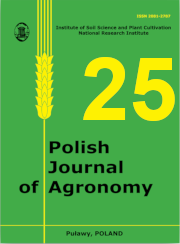YIELD OF WESTERWOLDS RYEGRASS CULTIVARS DEPENDING ON CROPPING REGION IN POLAND
Main Article Content
Abstract
The aim of this study was to assess the yield, distribution of yield over successive cuts and crop quality in cultivars of Westerwolds ryegrass (Lolium multiflorum Lam. var. westerwoldicum Wittm) grown for forage in selected regions of Poland. The study was based on the results of variety tests run by COBORU (Centre for Variety Testing), carried out over the years 2006–2008 with the cultivars: late Telga, semi-early Kaja and early Bravis 1. The study was conducted in the following regions of Poland: north-western, central-western, southern and south-eastern. It was proved that the southern region, where the annual dry weight yield is about 26% higher than in the north-western and centralwestern regions, is the most suitable for growing Westerwolds ryegrass. In the southern region, early cv. Bravis 1 gave better yields than late Telga. In the south-eastern region, the highest yields were given by late cv. Telga. different heading times did not have an effect on dry weight production in the north-western and central-western regions. The highest dry weight yield was obtained from the first cut (32% of annual yield), and the lowest from the fourth (18%). Yields of late cultivars were similar in the second and third cut, whereas those of early and semi-early cultivars were 28–30% lower in the third cut than in the second.
Article Details

This work is licensed under a Creative Commons Attribution-ShareAlike 4.0 International License.
The author grants the editorial staff of the Polish Journal of Agronomy (abbreviated as PJA) a non-exclusive and royalty-free license to use the author's copyright in the paper/printed and electronic versions of his/her work published in PJA in Poland and abroad, in whole or in any part, including placing the work in electronic databases/databases locally or available on the Internet, for an unlimited period of time in the fields of exploitation specified in article 50 of the Copyright and Related Rights Act.
Manuscripts published in Polish Journal of Agronomy are available under a Creative Commons Attribution-ShareAlike 4.0 (CC-BY-SA) license.

